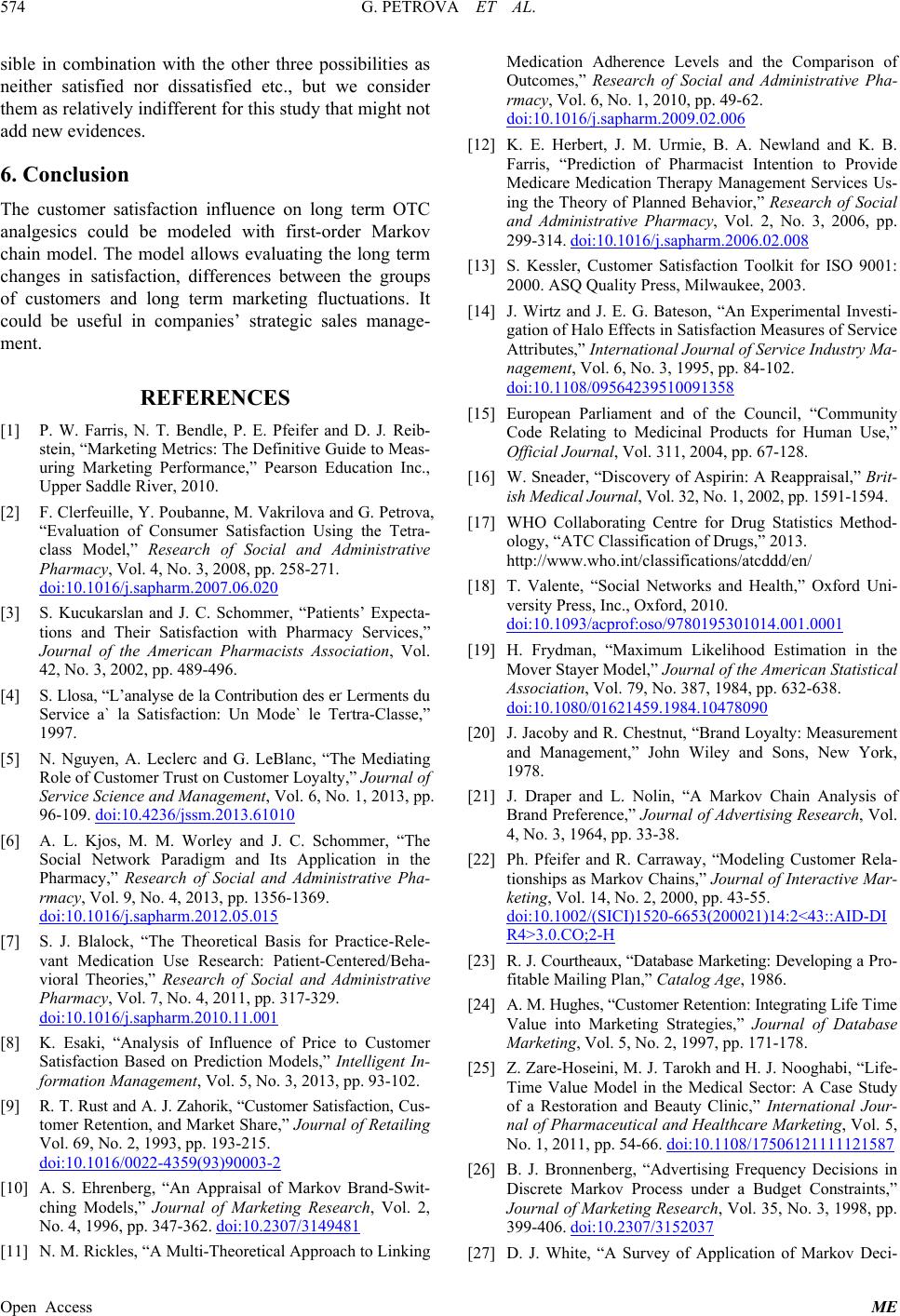
G. PETROVA ET AL.
574
Open Access ME
sible in combination with the other three possibilities as
neither satisfied nor dissatisfied etc., but we consider
them as relatively indifferent for this study that might not
add new evidences.
6. Conclusion
The customer satisfaction influence on long term OTC
analgesics could be modeled with first-order Markov
chain model. The model allows evaluating the long term
changes in satisfaction, differences between the groups
of customers and long term marketing fluctuations. It
could be useful in companies’ strategic sales manage-
ment.
REFERENCES
[1] P. W. Farris, N. T. Bendle, P. E. Pfeifer and D. J. Reib-
stein, “Marketing Metrics: The Definitive Guide to Meas-
uring Marketing Performance,” Pearson Education Inc.,
Upper Saddle River, 2010.
[2] F. Clerfeuille, Y. Poubanne, M. Vakrilova and G. Petrova,
“Evaluation of Consumer Satisfaction Using the Tetra-
class Model,” Research of Social and Administrative
Pharmacy, Vol. 4, No. 3, 2008, pp. 258-271.
doi:10.1016/j.sapharm.2007.06.020
[3] S. Kucukarslan and J. C. Schommer, “Patients’ Expecta-
tions and Their Satisfaction with Pharmacy Services,”
Journal of the American Pharmacists Association, Vol.
42, No. 3, 2002, pp. 489-496.
[4] S. Llosa, “L’analyse de la Contribution des eґ Leґments du
Service a` la Satisfaction: Un Mode` le Teґtra-Classe,”
1997.
[5] N. Nguyen, A. Leclerc and G. LeBlanc, “The Mediating
Role of Customer Trust on Customer Loyalty,” Journal of
Service Science and Management, Vol. 6, No. 1, 2013, pp.
96-109. doi:10.4236/jssm.2013.61010
[6] A. L. Kjos, M. M. Worley and J. C. Schommer, “The
Social Network Paradigm and Its Application in the
Pharmacy,” Research of Social and Administrative Pha-
rmacy, Vol. 9, No. 4, 2013, pp. 1356-1369.
doi:10.1016/j.sapharm.2012.05.015
[7] S. J. Blalock, “The Theoretical Basis for Practice-Rele-
vant Medication Use Research: Patient-Centered/Beha-
vioral Theories,” Research of Social and Administrative
Pharmacy, Vol. 7, No. 4, 2011, pp. 317-329.
doi:10.1016/j.sapharm.2010.11.001
[8] K. Esaki, “Analysis of Influence of Price to Customer
Satisfaction Based on Prediction Models,” Intelligent In-
formation Management, Vol. 5, No. 3, 2013, pp. 93-102.
[9] R. T. Rust and A. J. Zahorik, “Customer Satisfaction, Cus-
tomer Retention, and Market Share,” Journal of Retailing
Vol. 69, No. 2, 1993, pp. 193-215.
doi:10.1016/0022-4359(93)90003-2
[10] A. S. Ehrenberg, “An Appraisal of Markov Brand-Swit-
ching Models,” Journal of Marketing Research, Vol. 2,
No. 4, 1996, pp. 347-362. doi:10.2307/3149481
[11] N. M. Rickles, “A Multi-Theoretical Approach to Linking
Medication Adherence Levels and the Comparison of
Outcomes,” Research of Social and Administrative Pha-
rmacy, Vol. 6, No. 1, 2010, pp. 49-62.
doi:10.1016/j.sapharm.2009.02.006
[12] K. E. Herbert, J. M. Urmie, B. A. Newland and K. B.
Farris, “Prediction of Pharmacist Intention to Provide
Medicare Medication Therapy Management Services Us-
ing the Theory of Planned Behavior,” Research of Social
and Administrative Pharmacy, Vol. 2, No. 3, 2006, pp.
299-314. doi:10.1016/j.sapharm.2006.02.008
[13] S. Kessler, Customer Satisfaction Toolkit for ISO 9001:
2000. ASQ Quality Press, Milwaukee, 2003.
[14] J. Wirtz and J. E. G. Bateson, “An Experimental Investi-
gation of Halo Effects in Satisfaction Measures of Service
Attributes,” International Journal of Service Industry Ma-
nagement, Vol. 6, No. 3, 1995, pp. 84-102.
doi:10.1108/09564239510091358
[15] European Parliament and of the Council, “Community
Code Relating to Medicinal Products for Human Use,”
Official Journal, Vol. 311, 2004, pp. 67-128.
[16] W. Sneader, “Discovery of Aspirin: A Reappraisal,” Brit-
ish Medical Journal, Vol. 32, No. 1, 2002, pp. 1591-1594.
[17] WHO Collaborating Centre for Drug Statistics Method-
ology, “ATC Classification of Drugs,” 2013.
http://www.who.int/classifications/atcddd/en/
[18] T. Valente, “Social Networks and Health,” Oxford Uni-
versity Press, Inc., Oxford, 2010.
doi:10.1093/acprof:oso/9780195301014.001.0001
[19] H. Frydman, “Maximum Likelihood Estimation in the
Mover Stayer Model,” Journal of the American Statistical
Association, Vol. 79, No. 387, 1984, pp. 632-638.
doi:10.1080/01621459.1984.10478090
[20] J. Jacoby and R. Chestnut, “Brand Loyalty: Measurement
and Management,” John Wiley and Sons, New York,
1978.
[21] J. Draper and L. Nolin, “A Markov Chain Analysis of
Brand Preference,” Journal of Advertising Research, Vol.
4, No. 3, 1964, pp. 33-38.
[22] Ph. Pfeifer and R. Carraway, “Modeling Customer Rela-
tionships as Markov Chains,” Journal of Interactive Mar-
keting, Vol. 14, No. 2, 2000, pp. 43-55.
doi:10.1002/(SICI)1520-6653(200021)14:2<43::AID-DI
R4>3.0.CO;2-H
[23] R. J. Courtheaux, “Database Marketing: Developing a Pro-
fitable Mailing Plan,” Catalog Age, 1986.
[24] A. M. Hughes, “Customer Retention: Integrating Life Time
Value into Marketing Strategies,” Journal of Database
Marketing, Vol. 5, No. 2, 1997, pp. 171-178.
[25] Z. Zare-Hoseini, M. J. Tarokh and H. J. Nooghabi, “Life-
Time Value Model in the Medical Sector: A Case Study
of a Restoration and Beauty Clinic,” International Jour-
nal of Pharmaceutical and Healthcare Marketing, Vol. 5,
No. 1, 2011, pp. 54-66. doi:10.1108/17506121111121587
[26] B. J. Bronnenberg, “Advertising Frequency Decisions in
Discrete Markov Process under a Budget Constraints,”
Journal of Marketing Research, Vol. 35, No. 3, 1998, pp.
399-406. doi:10.2307/3152037
[27] D. J. White, “A Survey of Application of Markov Deci-